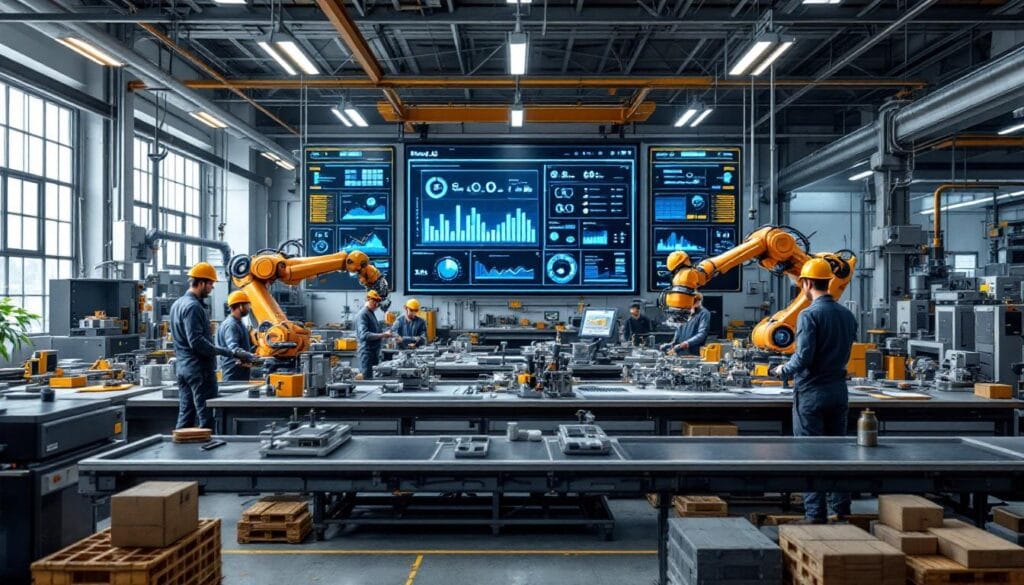The global manufacturing scene is undergoing a major transformation, and Latin America is positioning itself as a key player in this shift.
With its vast natural resources and technological potential, the region is attracting increasing attention from international investors.
The rise of Industry 4.0 plays a central role, redefining production and innovation dynamics.
This industrial revolution, marked by the integration of advanced technologies such as the Internet of Things and artificial intelligence, offers unprecedented opportunities for Latin American manufacturers. The ability to optimize processes and strengthen the resilience of supply chains becomes a major competitive advantage. However, the region must overcome several challenges to fully benefit from this digital transition. Government initiatives and private investments are essential to catalyze this evolution and position Latin America at the heart of the global manufacturing landscape.

In the midst of global transformation, Industry 4.0 is establishing itself as the catalyst for innovation and competitiveness. Latin America, rich in natural resources and manufacturing potential, is positioning itself as a key player in this technological revolution. This article explores how the region can leverage this opportunity to boost its industrial future.
Table des matières
ToggleWhat are the key resources driving industry 4.0 in Latin America?
Latin America is no stranger to the global manufacturing stage thanks to its abundance of natural resources such as coal, oil, and iron. Countries like Chile, Bolivia, and Argentina have immense reserves of lithium, essential for electric vehicle (EV) batteries. This wealth of resources positions the region as an indispensable supplier in the global supply chain.
Moreover, the region’s emergence as a manufacturing giant is not limited to resource extraction. Investments in advanced technologies and process optimization enable the transformation of these resources into high-value-added finished products. This dynamic is supported by local initiatives aimed at integrating technologies such as the Internet of Things (IoT) and artificial intelligence (AI), thereby strengthening the resilience and efficiency of supply chains.
What are the benefits of adopting industry 4.0 for Latin American manufacturers?
The adoption of Industry 4.0 offers a multitude of essential advantages for manufacturers in Latin America. According to Arturo Sanchez Cervantes, Director of Audit at RSM Mexico, improvements in manufacturing processes, resource optimization, and reductions in production costs are key factors that make companies more competitive in the global market.
Additionally, Nahuel Beccaria, partner at RSM Argentina, emphasizes that smart technologies like AI, automation, and IoT provide valuable insights for real-time decision-making processes, as well as for long- and short-term planning. These technologies also enable efficient integration of all participants in the value chain, from initial design to final product.
By integrating these technologies, companies can not only enhance the customer and manufacturing experience but also develop new products that meet needs and challenges identified through collected data. To learn more about how to make industry 4.0 accessible to all manufacturers, explore the ongoing initiatives.
What are the government levers to support industry 4.0 in Latin America?
Government support plays a crucial role in accelerating Industry 4.0 in Latin America. For instance, Brazil launched the action plan “New Industry Brazil: Action Plan” in January 2024, aiming to re-industrialize the country with a planned investment of 300 billion R$. This plan includes funding, tax incentives, public procurement, professional qualifications, and research and development to stimulate manufacturing innovation.
Cláudio Silva Foch, partner at RSM Brazil, explains that this plan relies on partnerships between the government, the private sector, and international organizations. This collaboration is essential to provide the necessary instruments for digital transformation, such as the Ericsson partnership program for wireless enterprise solutions related to Industry 4.0.
In Argentina, the Productive Development Plan Argentina 4.0 aims to support and encourage the digital transformation of local businesses. These government initiatives are essential to overcome financial and technical barriers, thus facilitating the adoption of advanced technologies.
What are the challenges to overcome for the adoption of industry 4.0 in Latin America?
Despite the undeniable advantages, the adoption of Industry 4.0 in Latin America faces several challenges. Gabriel Lupo, partner at RSM Argentina, observes that complexity, lack of public policies, insufficient support from management, and lack of specialized human resources are among the main barriers.
A joint study by the University of Salvador and the University of Buenos Aires, published in the Brazilian Journal of Education, Technology, and Society (BRAJETS), identifies these obstacles as the main hindrances to the adoption of 4.0 technologies in the region. The limitation of available capital to finance digital transformation is also a major issue, hindering the integration of cutting-edge technologies.
Furthermore, the limited number of specialized service providers for the supply and maintenance of 4.0 solutions represents an additional constraint. To address these challenges, the government has implemented public policies aimed at supporting and encouraging digital transformation, such as the Sustainable Development Plan.
How can Latin American companies improve their IT infrastructure for industry 4.0?
Digital transformation requires a robust and well-designed IT infrastructure. According to Arturo Sanchez Cervantes, mid-market manufacturers continually improve their processes by eliminating those that do not add value, thus laying the groundwork for further technological advancements. Implementing an effective data strategy is crucial for any successful digital transformation.
Cláudio Silva Foch adds that the collection, storage, analysis, and proper use of data enable more informed decision-making, making organizations more competitive on a global scale. The adoption of cloud solutions, investment in cybersecurity, partnerships with technology companies, and employee training are essential steps to strengthen IT infrastructure.
To facilitate this transition, initiatives like RS and Banner Engineering are working to make Industry 4.0 accessible to all sizes of businesses, offering solutions tailored to the specific needs of Latin American manufacturers.
What are the successful use cases of industry 4.0 in Latin America?
Several Latin American companies have already begun to leverage the advantages of Industry 4.0. In Indonesia, for example, the alliance between fashion and Industry 4.0 emphasizes sustainability, demonstrating how advanced technologies can be integrated into traditional sectors to improve efficiency and reduce environmental impact.
These initiatives show that the integration of 4.0 technologies is not limited to heavy industry but can also transform various sectors by improving processes, reducing costs, and increasing the quality of finished products.
For more inspiring examples and innovative solutions, explore the Launch of the Industry 4.0 Academy, a collaboration between NCPA LaunchBox and Penn State DuBois, aimed at training the next generation of Industry 4.0 professionals in Latin America.
What are the future impacts of industry 4.0 on the Latin American manufacturing landscape?
Industry 4.0 promises to profoundly transform the manufacturing landscape in Latin America. By integrating technologies such as IoT, artificial intelligence, and smart factories, companies can achieve new levels of efficiency and competitiveness. This digital transformation is essential to meet the growing demands of the global market and contemporary challenges, such as sustainability and resource management.
In the long term, successful adoption of Industry 4.0 could position Latin America as a leading manufacturing hub, attractive for international investments and capable of producing high-quality goods. However, this requires a continuous commitment to innovation, human resource training, and the development of adequate technological infrastructure.
In conclusion, although challenges remain, Latin America has the necessary assets to fully embrace Industry 4.0 and propel its industrial future to new heights. To stay informed of the latest trends and obtain practical advice, visit our dedicated manufacturing industry page.




